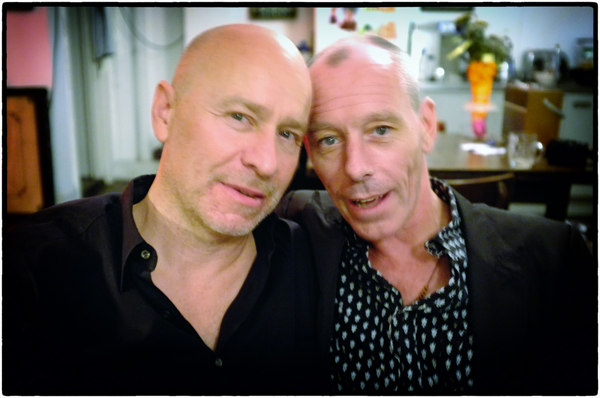[youtube width=”600″ height=”450″]http://www.youtube.com/watch?v=8M5xTPsA2ro[/youtube]
Cineola Volume 2: Moonbug, the soundtrack by THE THE to the award winning documentary feature film directed by Nichola Bruce is now available for purchase.
The film follows renowned photographer Steve Pyke on his extraordinary journey across America to meet, interview and photograph his childhood heroes – the men who went to the moon.
This 80 page deluxe hardback edition features 17 new tracks from THE THE, portraits of the Apollo astronauts by Steve Pyke, an extensive interview with Steve Pyke by Matt Johnson plus notes from the director and stills from the film.
____________________________________
Buy the Moonbug soundtrack Book/CD here
Visit Steve’s official site Pyke-Eye here
Read Pyke’s blog here
An extensive article about Pyke ‘The Englishman in New York talks portraits and cinematic influences’ by Peter Hamilton is in the February 2012 issue of the British Journal of Photography, available here
Find out about Nichola Bruce here
Find out about Moonbug the Movie here
[vimeo width=”600″ height=”450″]http://vimeo.com/18267299[/vimeo]
____________________________________
Excerpt from Steve Pyke in conversation with Matt Johnson.

Matt Johnson: There is one question I have to ask before we move onto other points and that is about the various conspiracy theories that have been circling for years? That the moon landings were a giant hoax aimed at the Soviet Union in order to strike a blow in the cold war space race that the USA was losing at the time. This would reassure the American public that the United States was as technologically advanced as the feared Soviets. You know the stuff, the angles are wrong with the shadows in the photographs, in some of the footage the astronauts look as if they are being held up like puppets on hidden wires rather than lack of gravity, that is was all secretly shot in the desert at Area 51, reminiscent of the movie Capricorn One. What do you think about these theories having now met the astronauts?
Steve Pyke: If I was to think of one question that people ask, and I think this is a real sign of the age we are in, the first question that comes up every time I’m asked what it was like to meet the astronauts is do you believe that it actually happened. What do the astronauts say about these conspiracy theories? Well, what are they supposed to say about it? It’s quite obvious, sitting in a room with somebody, sitting on the edge of a bed with somebody, sitting face to face with somebody that this thing actually happened to, there is no question that these things happened. You could read into trajectories of light and this doesn’t look right and it could all have been done on a Hollywood set and people will come up with these conspiracy theories as they often do.
MJ: Another controversial point it would be remiss of me not to mention is of course Operation Paperclip and the involvement of Nazi scientists and former SS members in NASA’s space programme. At the end of WW2 there was a race between the Americans and the Soviets to capture and enlist Nazi scientists in order to gain a military edge over each other. Consequently some strange collaborations ensued, some of which we know about, such as Project MK Ultra, Project Bluebird and Project Chatter but probably many that, to this day, we do not. The most benign of these collaborations was probably the Apollo programme but were you able to find out any more information that helps shed more light on this partnership?
SP: I’ve always had an interest in history and WW2 is close to my time. I was born 12 years after it ended. One of the questions I asked a lot of people who were involved in NASA, like Christopher Kraft and the older people within it, Max Faget as well, was about people like Wernher von Braun. They had dealings with him yet they weren’t judging him on the fact slave labour in Eastern Europe killed millions in order to send V2 and V1 rockets to Britain. They were judging him as a scientist and what he was technically capable of. What they and the American government at the time were interesting in was getting the brightest minds to work on space travel, well atomic power first and foremost, they were about harnessing these brains for war games not space games. So what came back from the people I spoke to about the German scientists, and there were many of them, I think there was a base in New Mexico, was great respect because without them this would not have happened. Without Wernher von Braun, without the research he originally did at Pennemünde on the German Baltic coast during the second world war, there was no way man would have walked on the moon. It wouldn’t have happened. So their recollections of him were respectful but there was also a humorous side, which all of them spoke about, that the Germans had these renowned drinking parties that used to go on for days at this station. I got the impression they were very closed German affairs but every now and then they would have a big party with all of the directors and technicians from Houston, you know there would be some reason that Wernher von Braun and the others would be in Houston, usually for a lift off, and it was accompanied with a big piss up. They were renowned drinkers.
MJ: The involvement of Nazi scientists is the dark side of the moon landings. Meanwhile the public were spoon-fed the myth that this was some heroic American adventure on behalf of the free world.
SP: What happened with the Germans is that they fled to the South of France, they headed down to Marseilles and were picked up there, actually they were picked up before they got to Marseilles apparently and were taken straight away to California and debriefed. They were incredibly compliant as they knew the way it was going, but looking at this on a wider level they were completely implicated within German state industry and the mass slavery of hundreds of thousands, millions of Eastern workers.
MJ: It’s an interesting fact that there was a lot of close cooperation between American corporations and the Nazis, from before the outbreak of WW2, all the way through and beyond, such as Ford supplying engines for a lot of German military hardware, Standard Oil supplying specialist chemicals and IBM supplying the punch card systems that were used in the concentration camps to process Jews, Gypsies, Communists and homosexuals. Corporate allegiance is to profit of course and not to people, or even to nations, but this stuff needs to be properly remembered especially in an age when corporations are more powerful than governments.
SP: As far as the astronauts were concerned the Germans were just part of the reason they were able to get there. A lot of the things that fire me up as a photographer are photographing people who’ve had an impact on the 20th century, my time, or who’ve witnessed these great events. We were talking earlier about Vietnam but the whole space race started at the point of idealism and America, at it’s post war height in the early 1960’s, with it’s manufacturing power, had a fantastic way of life.
Read the full in-depth interview inside the new Moonbug CD/Book. Purchase Here
